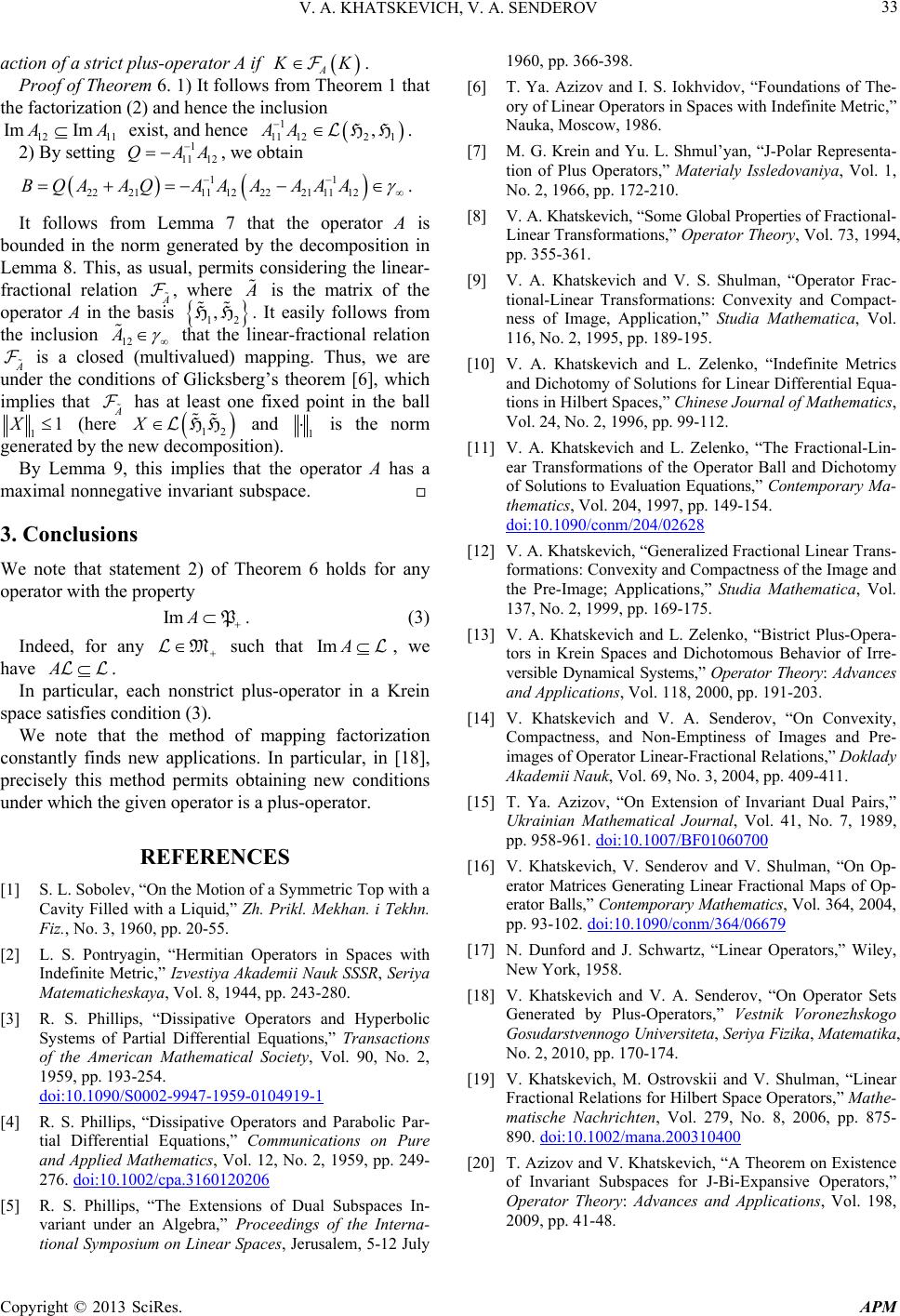
V. A. KHATSKEVICH, V. A. SENDEROV
Copyright © 2013 Sci APM
33
Res.
action of a strict plus-operator A if
AK
Im
.
Proof of Theorem 6. 1) It follows from Theorem 1 that
the factorization (2) and hence the inclusion
12 11
A
2 1
,HH
11
11 12
AA
exist, and hence .
1
11 12
AA
Im
2) By setting , we obtain
1
11 12
QAA
11 12
AA
22 2122 21
BQA AQAA
.
It follows from Lemma 7 that the operator A is
bounded in the norm generated by the decomposition in
Lemma 8. This, as usual, permits considering the linear-
fractional relation A
, where
12
,
HH
is the matrix of the
operator A in the basis . It easily follows from
the inclusion 12
A
that the linear-fractional relation
A
is a closed (multivalued) mapping. Thus, we are
under the conditions of Glicksberg’s theorem [6], which
implies that A
has at least one fixed point in the ball
11X (here and
12
HHX1
is the norm
generated by the new decomposition).
By Lemma 9, this implies that the operator A has a
maximal nonnegative invariant subspace.
3. Conclusions
We note that statement 2) of Theorem 6 holds for any
operator with the property
Im A
P
M
. (3)
Indeed, for any such that , we
have .
Im A
A
In particular, each nonstrict plus-operator in a Krein
space satisfies condition (3).
We note that the method of mapping factorization
constantly finds new applications. In particular, in [18],
precisely this method permits obtaining new conditions
under which the given operator is a plus-operator.
REFERENCES
[1] S. L. Sobolev, “On the Motion of a Symmetric Top with a
Cavity Filled with a Liquid,” Zh. Prikl. Mekhan. i Tekhn.
Fiz., No. 3, 1960, pp. 20-55.
[2] L. S. Pontryagin, “Hermitian Operators in Spaces with
Indefinite Metric,” Izvestiya Akademii Nauk SSSR, Seriya
Matematicheskaya, Vol. 8, 1944, pp. 243-280.
[3] R. S. Phillips, “Dissipative Operators and Hyperbolic
Systems of Partial Differential Equations,” Transactions
of the American Mathematical Society, Vol. 90, No. 2,
1959, pp. 193-254.
doi:10.1090/S0002-9947-1959-0104919-1
[4] R. S. Phillips, “Dissipative Operators and Parabolic Par-
tial Differential Equations,” Communications on Pure
and Applied Mathematics, Vol. 12, No. 2, 1959, pp. 249-
276. doi:10.1002/cpa.3160120206
[5] R. S. Phillips, “The Extensions of Dual Subspaces In-
variant under an Algebra,” Proceedings of the Interna-
tional Symposium on Linear Spaces, Jerusalem, 5-12 July
1960, pp. 366-398.
[6] T. Ya. Azizov and I. S. Iokhvidov, “Foundations of The-
ory of Linear Operators in Spaces with Indefinite Metric,”
Nauka, Moscow, 1986.
[7] M. G. Krein and Yu. L. Shmul’yan, “J-Polar Representa-
tion of Plus Operators,” Materialy Issledovaniya, Vol. 1,
No. 2, 1966, pp. 172-210.
[8] V. A. Khatskevich, “Some Global Properties of Fractional-
Linear Transformations,” Operator Theory, Vol. 73, 1994,
pp. 355-361.
[9] V. A. Khatskevich and V. S. Shulman, “Operator Frac-
tional-Linear Transformations: Convexity and Compact-
ness of Image, Application,” Studia Mathematica, Vol.
116, No. 2, 1995, pp. 189-195.
[10] V. A. Khatskevich and L. Zelenko, “Indefinite Metrics
and Dichotomy of Solutions for Linear Differential Equa-
tions in Hilbert Spaces,” Chinese Journal of Mathematics,
Vol. 24, No. 2, 1996, pp. 99-112.
[11] V. A. Khatskevich and L. Zelenko, “The Fractional-Lin-
ear Transformations of the Operator Ball and Dichotomy
of Solutions to Evaluation Equations,” Contemporary Ma-
thematics, Vol. 204, 1997, pp. 149-154.
doi:10.1090/conm/204/02628
[12] V. A. Khatskevich, “Generalized Fractional Linear Trans-
formations: Convexity and Compactness of the Image and
the Pre-Image; Applications,” Studia Mathematica, Vol.
137, No. 2, 1999, pp. 169-175.
[13] V. A. Khatskevich and L. Zelenko, “Bistrict Plus-Opera-
tors in Krein Spaces and Dichotomous Behavior of Irre-
versible Dynamical Systems,” Operator Theory: Advances
and Applications, Vol. 118, 2000, pp. 191-203.
[14] V. Khatskevich and V. A. Senderov, “On Convexity,
Compactness, and Non-Emptiness of Images and Pre-
images of Operator Linear-Fractional Relations,” Doklady
Akademii Nauk, Vol. 69, No. 3, 2004, pp. 409-411.
[15] T. Ya. Azizov, “On Extension of Invariant Dual Pairs,”
Ukrainian Mathematical Journal, Vol. 41, No. 7, 1989,
pp. 958-961. doi:10.1007/BF01060700
[16] V. Khatskevich, V. Senderov and V. Shulman, “On Op-
erator Matrices Generating Linear Fractional Maps of Op-
erator Balls,” Contemporary Mathematics, Vol. 364, 2004,
pp. 93-102. doi:10.1090/conm/364/06679
[17] N. Dunford and J. Schwartz, “Linear Operators,” Wiley,
New York, 1958.
[18] V. Khatskevich and V. A. Senderov, “On Operator Sets
Generated by Plus-Operators,” Vestnik Voronezhskogo
Gosudarstvennogo Universiteta, Seriya Fizika, Matematika,
No. 2, 2010, pp. 170-174.
[19] V. Khatskevich, M. Ostrovskii and V. Shulman, “Linear
Fractional Relations for Hilbert Space Operators,” Mathe-
matische Nachrichten, Vol. 279, No. 8, 2006, pp. 875-
890. doi:10.1002/mana.200310400
[20] T. Azizov and V. Khatskevich, “A Theorem on Existence
of Invariant Subspaces for J-Bi-Expansive Operators,”
Operator Theory: Advances and Applications, Vol. 198,
2009, pp. 41-48.